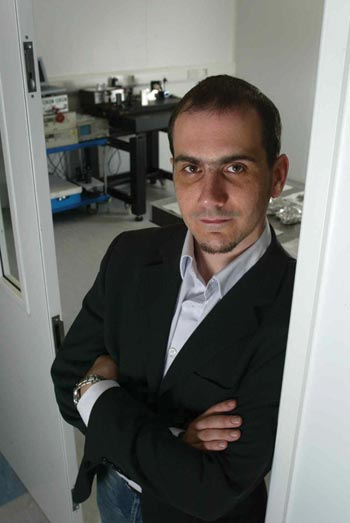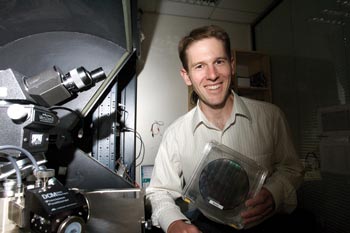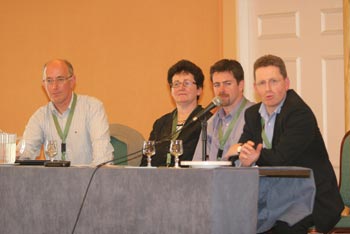They face an army of challenges and, as they do, they risk their careers, their sanity and their social lives. Why do they do it? Often, they just want to see something useful coming out of their research. They want to develop new personal skills and fulfil their potential. They do it for excitement. Very few do it just for the money.
Interviewed four people who have founded companies based on new photonics technologies developed in their research. They range in age from 34 to 49, and their companies have spun out from universities in England, Scotland and Ireland, although one individual is American and another French by birth. Besides the aspirations and talents of these individuals, the culture and infrastructure of their surroundings turn out to be very important enabling factors.
Some people are natural entrepreneurs and purposefully assemble the technology, skills set and contacts to spin off their companies. Others follow a longer path, gradually coming round to the view that commercialization is a worthwhile pursuit.
Controlling his own destiny
Erwan Normand, 34, is chief scientific officer and director of Cascade Technologies Ltd., which was founded in 2003 to use quantum cascade lasers for identifying and measuring industrial gases. He came from France to the UK in 1995, intending to stay for two to three years, but his involvement in methane gas sensing at the National Physical Laboratory piqued his interest in laser research. He moved to Glasgow, where he was accepted as a doctoral student at the University of Strathclyde.

Erwan Normand founded Cascade Technologies Ltd. in 2003, a spinout from the University of Strathclyde.
Normand had always been interested in setting up his own technology spinout company. “My parents have entrepreneurial thought processes, and I wanted to be in control of my own destiny. If I wasn’t going to do it, who was going to take the research results out there?”
While conducting his doctoral research, he attended classes at the university’s Hunter Centre for Entrepreneurship. This equipped him with a road map on how to set up his company, providing information on accessing resources, funding and team building. When he reached the end of his doctoral funding, he set to work straight away to start his own company.
“I found the infrastructure at the university very supportive,” he said. “I think the UK and US are quite good at that.” Strathclyde University Incubator funding started things off, and a presentation pitch attracted the management team and further funding. Normand did consider setting up his company in France, but the infrastructure at the time proved better in Glasgow, and the incubator process less complex.
“Setting up a company is very time-consuming,” he said. “There are new challenges all the time as the company grows. You have to reorganize your life, because it is not a 9 to 5 job, especially with the responsibilities involved in being a director. You have to decide: Do you want risk in your life or not? But the reward is you develop your skills very quickly.”
Risky, but rewarding
John D. Lambkin took a longer route to entrepreneurship but devised a business model that makes his company virtually unique in optoelectronics: It is a fabrication-less company.
Firecomms of Cork, Ireland, carries out the research and development, prototyping, characterization and product qualification in-house and contracts the manufacture to third-party companies. This reduces capital expenditure, provides flexibility for growth and leverages the expertise and quality control skills of the external companies.
Lambkin, 45, co-founded the company in May 2001 and is chief technical officer.
“Looking back, I was very naïve, and it has taken longer and much more effort to get to where we are today than I ever expected,” he admitted. “The company is venture capital-funded, and the success of the company will be measured by the return on their investment.
“However,” he added, “I am motivated first and foremost by having Firecomms recognized as successful in manufacturing and shipping high-quality products based on our innovative technology. I’ll admit, of course, that the money will come in handy when we float on the stock market.”
Lambkin had two daughters under age 4 when he spun off his company. The job involved a lot of travel and had a major impact on his family, but he has survived it by minimizing travel during weekends and making time for his children before doing late-evening work.
At first, it was particle physics and astrophysics that captured his interest, but later, he turned to applied research on semiconductor quantum wells. During his postgraduate study, he attended a course given by the Engineering and Physical Sciences Research Council, which presented options to academic careers. That is when he realized that industry could be invigorating and challenging.
While a postdoctoral researcher, Lambkin moved to Ireland to the research centre in Cork now known as Tyndall National Institute. There he experienced an exciting culture of investment in optoelectronics, along with an ethos of applied research for spin-off. After his research had reached the stage where companies were contacting him about using the technology, he recognized that his technology was ready to spin out.
He readily acknowledges the importance of the people who co-founded Firecomms.
“Technology entrepreneurs have to understand their own limitations and the importance of finding partners with the right business and commercial background,” he said. “My contribution was giving up my secure job, because I really believed in the company. It’s a risky thing to do, a gamble at that stage in your career. But it’s fantastically rewarding.”
Ireland: a great place to do business
Another spin-off from Tyndall is SensL, which makes solid-state low-light sensors for telecoms and cell imaging, security and radiation detection.

Carl Jackson (left) is chief technology officer at SensL, which manufactures low-light sensing devices such as the silicon photomultiplier wafer he is holding. In the background is the semiautomatic wafer probe station for wafer-level testing.
Carl Jackson, chief technology officer for the company, is 34 and was born in the US. He formed his first company, Photon Detector Systems (PDS) Ltd. while writing his doctoral thesis. Even at a young age, he said, he had thoughts of setting up his own technology company, following a path that put him more in control.
When he formed PDS, he originally wanted to stay at the National Microelectronics Research Centre (now Tyndall) in Cork and run the company from inside it, designing light detectors, building prototypes and working on the low-light detector technology he pioneered there.
“But this didn’t fly,” he said, because the environment was not suitable at the time to do this from within the research centre structure. That’s when Jackson left the centre and set up PDS with his own limited backing. “I didn’t have any money, so this was mostly just my time I had to put into the company,” he said.
For the most part happy with PDS, Jackson knew he needed venture capital to commercialize his low-light detector technology. “We needed a wafer probe station, high-tech measurement equipment and money for silicon wafer runs to make this happen,” he said. That’s when he met Joe O’Keeffe, a man experienced in high-tech start-up who learned of Tyndall through work he had done with another Tyndall start-up called eTyndall.
O’Keeffe was looking specifically for technology ready to spin out, and that’s when, in 2004, Jackson, O’Keeffe and another of the technology founders from Tyndall, Alan Mathewson, founded SensL. SensL was structured as an equal partnership between the technology developers, Jackson and Mathewson, and the business side of the company, run by O’Keeffe.
Shortly after forming SensL, they brought in Joe Gantly, former head of Apple Europe, to provide them with additional management expertise and, in 2007, they hired Stephen Keeney, who was a corporate director with Intel, as their chief operating officer. Now there are 17 employees and a host of contractors who work extensively to develop SensL’s novel low-light-detector solutions.
“In contrast to running a one-man company, with more people to support you, there’s more you can do,” Jackson said. “With the team I have in place now, I can devote my time to working directly with customers and learning how we can best serve them.”
When Jackson and his Irish wife were figuring where they would choose to live, they selected Ireland, to a large degree because the government was putting so much money into new companies. “The Irish government funding programs are very supportive of new technology,” he said. “I think for starting up a small venture, given the access to start-up funding, talented work force and ready access to European and American markets, there really is no better place to do this than Ireland.”
Commenting on the differences between Europeans and Americans, Jackson offered that Europeans are more afraid of failing. “In the States, if you have failed, the consensus seems to be that you must have learned something, and that failure is treated almost as a badge of honor or a rite of passage.” He also believes that this would change as more people become used to the idea of entrepreneurship as a career.
Incubated in London
In 2006, Midaz Lasers Ltd. spun out from the Photonics Group at Imperial College London. The company is in the new incubator area of the campus, so Michael Damzen, 49, founder, director and chief technology officer, can devote enough effort to it and still pursue his academic career as professor of experimental and laser physics at the college.
In 2007, the Optical Society of America awarded Damzen a fellowship “for contributions to optics and laser physics over more than 25 years.” He is well established in his academic career, with a research team and many publications to his name. “Now,” he told me, “I am ready for a new personal challenge.”
Damzen’s work on microslab laser technology has matured and is ready for applications in industrial silicon processing at the nano- and microscale level for consumer electronics such as mobile phones. Imperial College has a technology transfer office called Imperial Innovations Group plc that is floated on the stock market and raising £40 million, a venture capital company in its own right. It funded the start-up in conjunction with a business angel and put Damzen in contact with key people.
When asked why he didn’t spin off with the company, Damzen said that the option remains open, but that as the company succeeds, it will need him less. He is more motivated by putting the technology to use than by making money. He pointed out how very time-consuming his work is, largely because he has no help with research supervision or reduction in teaching timetables. Personal burnout is the risk he takes. However, he said, the situation is temporary, and “dealing with the real world enriches academic life and brings something back into the research – if one can survive.”

John Lambkin from Firecomms (extreme right) is shown on the Industry Panel at the Photonics Ireland Conference, the first one organized by the Irish Optics and Photonics Network. Also pictured are Martin Hynes from IRCSET; Una Murphy from the National University of Ireland (NUI), Galways’ Applied Optics group; and John Dunne from Intune Networks. Reprinted with permission of Applied Optics, NUI Galway.
If there is one thing that all four entrepreneurs agree on, it is the importance of a team of people with complementary skills.
Dennis Camilleri of IVO Associates, a consultant who helps spin out and develop photonics companies, told me, “The inventor has to recognize early on that they simply can’t do everything themselves. They need a professional business and management team, and strong sales and marketing.” Entrepreneurship seems to be addictive. Camilleri himself is an entrepreneur.
They make up a special clan of businesspeople, and many relish the challenge. Take John Lambkin. Asked what he would do if he sold Firecomms, he said he would probably “go off on another roller coaster. I love the buzz of a small company.”